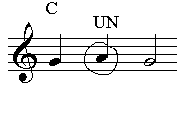
A non-harmonic tone is a note that does not belong to the chord in effect at the moment. They are more likely to happen on weak beats (i.e. beats 1 and 3 in a time signature of 4/4), notes of short duration, and beats on which the chord does not change.
In this summary table below, a "step" means either a half step or whole step, depending on what degrees of the scale you are using. A "leap" is a movement of more than a step. Click on any of the types to jump directly to the examples below. Some of the tones in the table below are grouped in pairs, shown by color. For example, upper and lower neighbors are the opposites of each other in one way: one is approached by a step up, the other by a step down. Appoggiatura and escape tone are similar but different in their approach and resolutions, as are anticipation and suspension.
|
type |
relation with chord tones |
approached |
resolved |
| passing tone | between two chord tones | step up or down | step continuing in same direction as approach |
| upper neighbor | between two chord tones | step up | step down |
| lower neighbor | between two chord tones | step down | step up |
| appoggiatura | leap | step (usually in the opposite direction than the leap before it) | |
| escape tone | step | leap | |
| anticipation | a non-chord tone when first played, it becomes a chord tone when it continues and the chord changes | any interval | continues on same note either by repeating or prolonging it |
| suspension | a chord tone when first played, becomes a non-chord tone when it continues and the chord changes | continues on from same note either by repeating or prolonging it | step down |
| pedal tone | a long note that is held while a series of chords is changed above it | continues on the same note | continues on the same note |
Passing tones (PT) may occur on a strong or weak beat and occur between two chord tones (CT). They are accented when they fall on a strong beat and unaccented when they occur on a weak beat. They may be diatonic (in the scale of the tonic) or chromatic. These are the most common type of non-harmonic tones and stick out the least. There may be more than one passing tone as long as the line continues in the same direction, starting and ending on a chord tone, with the passing tones in between.

Neighbor tones are the next most common type of non-harmonic tones after passing tones. They are the middle note in a three-note group, with the same chord tone before and after it. They are approached by whole- or half-step. When the the non-chord tone is above the chord tone the neighbor is an upper-neighbor (UN), when it is below the chord tone it is a lower-neighbor (LN).
The difference between a neighbor and a passing tone is that with the passing tone the movement contines in the same direction (for example, if "D" is the non-chord tone in the sequence "C", "D", "E" you go up from "C" to "D", and then continue going up to "E"), while with neighbors you turn around after the non-chord tone and go back to the note that preceded it (i.e., if "D" is the non-chord tone in the sequence "C", "D", "C", you go up from the "C" to the "D", and then go back down from the "D" to the "C"). In other words, with neighbor tones you always end up back on the note you started on, while with passing tones you end up on a new note.
 |
|
The term appoggiatura (APP) comes from the Italian work appoggiare, or "to lean". It is one of the stronger kinds of non-harmonic tone and usually occurs on a strong beat. It is usually approached by a leap (more than a step) and resolves by stepwise movement downwards to a chord tone.

The escape tone (ET) is sort of the opposite of the appoggiatura, approached by stepwise movement and resolved by a leap.

The anticipation (ANT) is a non-harmonic tone that is a non-chord tone when played, but while it is held or repeated it becomes a chord tone due to the harmony changing underneath it.

The suspension (SUS) is the opposite of an anticipation. It is a chord tone when first played, becoming a non-chord tone when the chord changes underneath it. It resolves down by step or half-step to a chord tone.

A pedal tone (PED) is long note that is held while the harmony changes. It usually takes place in the bass, with the chords changing above it. Organists play pedals with their feet in addition to playing the keys with their fingers. This term probably gets its name from that tradition, with the organist holding down one of the pedal notes with their foot while the chords changed on the keyboard.

©2002 Robert Willey